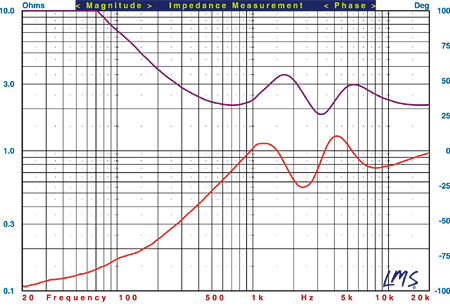Genesis 6.1 5.1-channel speaker system Measurements
For logistical reasons, the samples measured were different from those auditioned by SS.
Normally, we describe the results of our impedance tests but do not print the actual curves. We make an exception here for the Genesis 6.1 in Fig.1, and for the Genesis 6.1c center speaker in Fig.2, because the measurements are so atypical. The impedance values dip unusually low for both speakers: 2.13ohms at 700Hz and 1.81ohms at 3.2kHz for the G6.1; 1.56ohms at 60Hz and 1.46ohms at 300Hz for the G6.1c. These figures suggest that the speakers will be challenging to drive—even though the phase angles associated with these minimum values are relatively benign.

Fig.1: Genesis 6.1, impedance magnitude (purple) and phase (red).

Fig.2: Genesis 6.1c, impedance magnitude (purple) and phase (red).
The midrange sensitivity of the G6.1 is approximately 89dB/W/m. The speaker's horizontal front response is shown in Fig.3 (violet curve). This is the pseudo-anechoic response averaged over a 30° forward horizontal angle, at tweeter height, combined with the nearfield responses of the woofers and port. The only troublesome feature here is the peak at about 750Hz. It did not, however, appear to be a factor in SS's listening tests.

Fig.3: Genesis 6.1, pseudo-anechoic response off horizontal axis at 45° (red) and 60° (blue).
The driver layout of the G6.1 is slightly asymmetrical; our off-axis measurements were taken toward the tweeter side. The off-axis response (Fig.3) is noticeably more uneven than the on-axis average. It does, however, follow the on-axis response fairly well, except for a noticeable suckout just above 3kHz and the expected rolloff at the highest frequencies (though the latter is a bit more rapid than we typically see). The contribution of the rear tweeter does not show in these curves.
At the bottom end, the bass is remarkably smooth, flat, and extended—in fact, it is nearly flat down to 20Hz at the modest output level used in the mea-surements. This is perhaps the best bass extension we have ever measured in a full-range loudspeaker; the powered bass of the G6.1 is a true subwoofer, and many buyers will have no need of separate, outboard subs, particularly in a room of average size.
Fig.4 shows the same averaged horizontal front response (purple curve), this time overlaid with the vertical responses taken at +15° (red) and –15° (blue). The above-tweeter-axis response shows a significant dip at around 3.5kHz, the below-axis a broader, less prominent rise centered around 2.5kHz. The best listening axis should be on or slightly below the tweeter.

Fig.4: Genesis 6.1, pseudo-anechoic response at 15° above (red) and 15° below (blue) tweeter.
The Genesis 6.1c's sensitivity measured approximately 89dB/W/m. Its measured front horizontal response, taken on the tweeter axis and averaged in the same manner as described above for the G6.1, is shown in Fig.5 (violet curve). The effective bass extension is approximately 49Hz (–10dB). The G6.1c's response is more uneven than that of the G6.1. The bass is smooth, but there's a dip in the low-mid treble that reaches a maximum at about 5.5kHz. The off-axis response tracks the on-axis average reasonably well up to 45°, apart from the typical high-frequency rolloff. The vertical off-axis response (Fig.6) suggests that the best listening position with the G6.1c will be just slightly below the tweeter.

Fig.5: Genesis 6.1c, pseudo-anechoic response off horizontal axis at 45° (red) and 60° (blue)

Fig.6: Genesis 6.1c, pseudo-anechoic response at 15° above (red) and 15° below (blue) tweeter
The midrange and treble controls operated as specified. The measurements shown are without grilles, but we also measured the G6.1 with its grille in place. The results were nearly unchanged, with just a slight loss in the high frequencies and a little more ripple in the response; none of the deviations amounted to much more than 1dB.
While the measurements of the Genesis 6.1 and G6.1c are not the most impressive we've seen, the results of SS's listening tests command attention. For a discussion of the pros and cons of listening vs. measurements, I can do no better than direct the reader to John Atkinson's "As We See It" editorial in the January 2004 issue of our sister publication, Stereophile, which crossed my desk just as I was writing this.
My main concern with both of these speakers is their difficult impedance—the lowest I can recall ever measuring for SGHT. Only an amplifier comfortable with driving loads down to 2ohms—and even slightly lower—need apply. This system will be extremely sensitive to the electronics in front of it, not only because it is inherently revealing, but also because it challenges the amp's power-delivery capabilities. This is relieved only slightly by the fact that the G6.1's bass is handled by its onboard subwoofer, thus relieving the amp of the power-sapping bass chores in the left and right channels—and perhaps the center as well, if you designate the G6.1c as Small in setup.—Thomas J. Norton
- Log in or register to post comments




































































